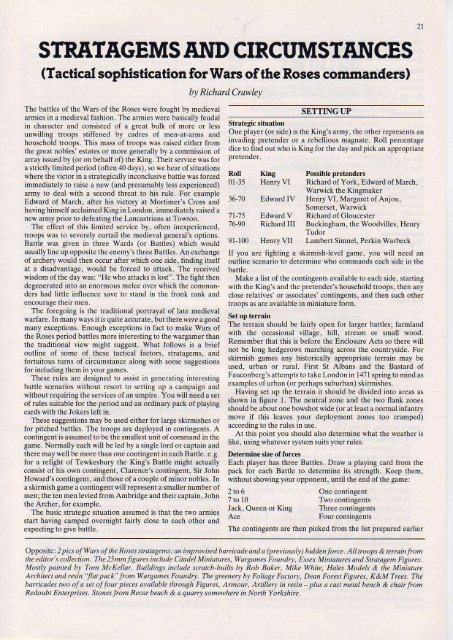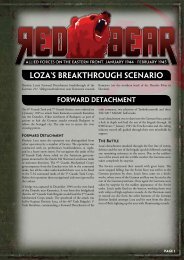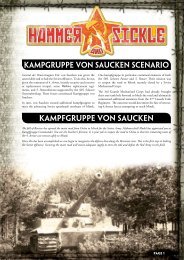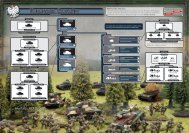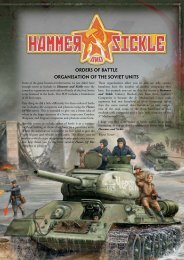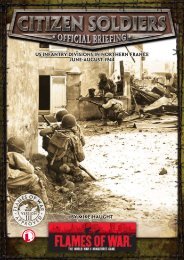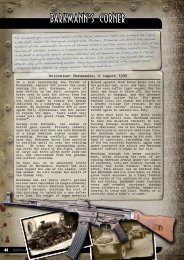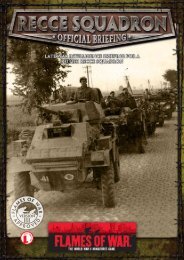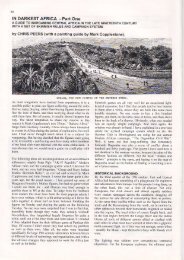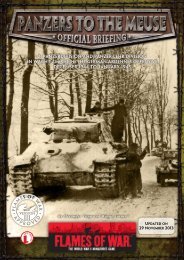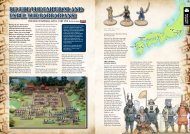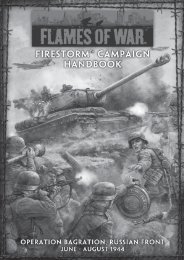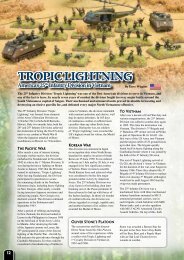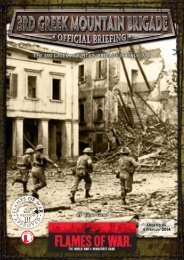Download a PDF version of this article here... - Flames of War
Download a PDF version of this article here... - Flames of War
Download a PDF version of this article here... - Flames of War
You also want an ePaper? Increase the reach of your titles
YUMPU automatically turns print PDFs into web optimized ePapers that Google loves.
STRATAGEMS AND CIRCI'MSTANCES<br />
(Tacttcal sophtstlcatlon for<strong>War</strong>s <strong>of</strong> the Roses commanders)<br />
The battles <strong>of</strong> the Wan <strong>of</strong> the Roses were fought by medieval<br />
armies in a medieval fashion. The arrnies were basically feudal<br />
in character and consisted <strong>of</strong> a great bulk <strong>of</strong> more or less<br />
unwilling troops stiffened by cadres <strong>of</strong> men-at-arms and<br />
household troops. This mass <strong>of</strong> troops was raised either from<br />
the great nobles' estat€s or more generally by a conmission <strong>of</strong><br />
array issued by (or on behaf <strong>of</strong>) the King. Their service was for<br />
a stricdy<br />
w<strong>here</strong> the victor in a strategically inconclusive battle was forced<br />
immediately to raise a new (and pr€sumably less expedenced)<br />
limited pedod (<strong>of</strong>ten 40 dayt, so we hear <strong>of</strong> situations<br />
by Richard Crawley<br />
army to deal with a second threat to his rule. Fot example<br />
Edward <strong>of</strong> March, after his victory at Mortimer's Crcss and<br />
having himsef acclaimed King in lrndon, immediately raised a<br />
new army p.ior to defeating the Lancastrians at Towton.<br />
The effect <strong>of</strong> <strong>this</strong> limited service by, <strong>of</strong>ten inexp#enced,<br />
troops was to severely curtail the medieval general's options.<br />
Battle ltras given in three <strong>War</strong>ds (or Baules) which would<br />
usually line up opposite the enemy's three Battles. An exchange<br />
<strong>of</strong> archery would then occur after which one side, finding itself<br />
at a disadvantage, would be forced to attack. The received<br />
wisdom <strong>of</strong> the day was:<br />
"He who attacks is lost". The fight then<br />
degenerated into an enomous melee overwhich the comman,<br />
ders had little influence save to stand in the fronk rank and<br />
encourage mer men.<br />
The foregoing is the tmditional portrayal <strong>of</strong> late medieval<br />
warfare. In many ways it ri quite accurate, but t<strong>here</strong> p€re a good<br />
many exceptions. Enough exceptions in fact to make <strong>War</strong>s <strong>of</strong><br />
the Roses period battles more interesting to the wargamer than<br />
the tmditional view might suggest. What follows is a brief<br />
outline <strong>of</strong> some <strong>of</strong> these tactical factols, stratagems, and<br />
fortuitous tums <strong>of</strong> circumstance along with some suggestions<br />
for including them in youlgames.<br />
used, wban or rural. First St Albans and the Bastard <strong>of</strong><br />
These rules are designed to assist in generating interesting<br />
Fauconberg'sattemptsto take London in 1471 springto mindas<br />
battle scenaios without resort to setting up a campaign and<br />
examples <strong>of</strong> urban (or perhapsuburban) skirmishes.<br />
without requiring the services <strong>of</strong> an umpire. You will need a set<br />
Having set up the terrain it should be divided into areas as<br />
<strong>of</strong> rules suitable for the period and an ordinary pack <strong>of</strong> playing shown in figure 1. The neutnl zone and the two flank zones<br />
€ards with the Jokers left in.<br />
should be about one bo*shot wide (or at least a normal infantry<br />
These suggestions may be used either for large skirmishes or<br />
move if <strong>this</strong> leaves youl deployment zones too cramped)<br />
for pitched battles. The troops are deployed in contingents- A<br />
according to the rules in use,<br />
contingent is assumed to be the smallest unit <strong>of</strong> command in the<br />
game. Normally each \rill be led by asingle lord or captain and<br />
t<strong>here</strong> may well be more than one contingent in each Battle. e,9.<br />
for a refight <strong>of</strong> Tewkesbury the King's Battle might actually<br />
consist <strong>of</strong> his own contingent, Clarence's contingent, Sir John<br />
Howad\ contingent, and those <strong>of</strong>a couple <strong>of</strong>minornobles. In<br />
a skirmish game a contingent will represent a smaller number <strong>of</strong><br />
men;theten men levied from Ambridge and theircaptain, John<br />
the Archer, for €xample.<br />
The basic strategic situation assumed is that the two armies<br />
start having camped overnight fairly close to each other and<br />
expecting to give battle.<br />
SETTINGIJP<br />
Straaegic sihration<br />
One player (or side) is the King'sarmy, the other rcpresents an<br />
invading pretender or a rebellious magnate. Roll percentage<br />
dice to find out who is King for the day and pick an appropriate<br />
RoI King Pocsible pretenders<br />
01-35 Henry VI Richard <strong>of</strong> York, Edward <strong>of</strong> March,<br />
<strong>War</strong>wick the Kingmaker<br />
36-70 Edward Menry VI, Margaret <strong>of</strong> Anjou,<br />
Somerset, <strong>War</strong>wick<br />
7l-75 Edward V Richard <strong>of</strong>Gloucesrer<br />
76-90 Richard III Buckingham, the Woodvilles, Henry<br />
Tudor<br />
91-100 Henry VII lnmbert Simnel, Perkin <strong>War</strong>beck<br />
If you are fighting a skirmishlevel game, you will need an<br />
outline scenario to determine who comnands each side in the<br />
battle.<br />
Make a list <strong>of</strong> the contingents available to each side, starting<br />
with the King'sand the pret€nd€r's household troops, then any<br />
close relatives' or associates' contingents, and then such other<br />
troops as are available in miniatur€ folm.<br />
Set up t€rraitr<br />
The terrain should be fairly open for larger battles; farmland<br />
with the occasional village, hill, stream or small wood.<br />
Remember that thh h before the Enclosure Acts so t<strong>here</strong> will<br />
not be long hedgerows marching across the countryside. For<br />
skirmish games any historically appropdate terrain may be<br />
At <strong>this</strong> point you should also determine *hat the \reather is<br />
like, using whatever system suits your rules.<br />
Iht€Imirc size <strong>of</strong> forces<br />
Each player has three Battles. Draw a playing card from the<br />
pack for each Battle to determine its strength. Keep them,<br />
without sho$ing your opponent, until the end <strong>of</strong> the game:<br />
2to 6<br />
7to10<br />
Jack, Queen or King<br />
One contingent<br />
Two contingents<br />
Thrce contingents<br />
Four contingents<br />
The contingents are then picked Iiom the list prepared earlier<br />
Opposire: 2 pics <strong>of</strong> <strong>War</strong>s <strong>of</strong> the Rosestatagems: an improvised barriude and a (prcviously) hidden force. AU noops & teftain from<br />
the editot's co ection. The 25mn frgurcs include Citadel Miniaturcs, <strong>War</strong>games Foundty, Essex Miniaturcs and Stratagem Figurcs.<br />
Mostly painted by Ton McKe aL Buidings include scnkh builts by Rob Bake\ Mike White, Hales Modeb & the Miniature<br />
Archited and rcsin "flat pick" lrcm <strong>War</strong>yames FoM&t. The Brcenery by Foliage Factoty, Dean Forcst Figures, K&M Trces. The<br />
banicades ttro <strong>of</strong>aset <strong>of</strong> fou pieces awilable thrcugh Figuret, Amour, A i ery in rcsin - plus a cast metal bench & chai lrom<br />
Redoubt Enteryrises. Stones from Recar beach & a quarry somewherc in No hYorkshbe.<br />
21


